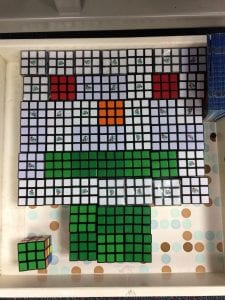 I have always loved the simple complexity of the 3×3 Rubik Cube. I first got my hands on one in 1979 and learned quite quickly that the solution only involved a few algorithms that are repeated. I spent the next few years showing off my skills to anyone willing to watch me be brilliant, if only for a few minutes! Even after all these years, I still get a kick out of solving it.
I have always loved the simple complexity of the 3×3 Rubik Cube. I first got my hands on one in 1979 and learned quite quickly that the solution only involved a few algorithms that are repeated. I spent the next few years showing off my skills to anyone willing to watch me be brilliant, if only for a few minutes! Even after all these years, I still get a kick out of solving it.
I have used them in my classrooms here and there for the past few years, but this year at TAGT I discovered that you can rent them! Oh what joy to behold! I placed an order that same morning, and soon there were 50 Rubik Cubes on my doorstep.
I sat them in the corner of my MakerSpace table for two weeks before I mentioned them. Several students asked to borrow a cube and had played around on them. One of my third graders knew how to solve one, which piqued the interest of several of his classmates. Two weeks into the loan, I sat my students down and explained that we were going to learn how to solve one face of the cube, and then create a mosaic with them.
For the next 30 minutes, I had their complete attention. 100% engaged! What a great learning experience! What a great teaching experience! I loved it and the students loved it. They learned, they encouraged each other, they worked together. Most of them solved the one side within in the hour and the rest who wanted to learn made their side in the next few days. By the end of the day – to my amazement – the students had got the idea and created their own mosaic! (see below)
It took another three weeks of allowing them to work during their own time – mainly recess and when work was finished – for three students to create our first mosaic from a pattern. They downloaded it from the website and used 36 cubes. They showed initiative, tenacity, group work, and teamwork, and were all in! 100 percent.
A week later my second self-motivated, self-directed, self-organized group of six, eight-year-olds had started another mosaic. Not to be outdone by group one, they had designed their own mosaic and were going to use 49 cubes. This was, in their determination, the largest mosaic that could be created with 50 cubes in a square. As they progressed they had a few discussions about creating the square and decided, by a quorum, to remove some squares from “blank” parts of the picture, to make the mosaic bigger as they were limited to 50 cubes.
I love watching students rise to a challenge. I especially love watching them learn something new that, although difficult, they take on with every belief that they can master it. Even if, as has happened so many times in my class, they fail the first few times. I love watching them encourage one another and bring in more friends to make their plans a reality.
We are hoping to get one more picture created before we send our cubes back. The students want to create something that involves everyone doing one cube. A lofty goal that will take some organization. But I believe they can do it. As their teacher, I get to facilitate the marvels that they achieve, the progress they make together, and the environment in which they work together and encourage one another to have …100% engagement!
Rubik cubes are for rent – see the link below. I rented 48 and paid shipping to send them back after a few months. This year I am going to rent 100!
https://www.rubiks.com/contact/i-want-to-create-art-made-from-rubiks-cubes


 I have always loved the simple complexity of the 3×3 Rubik Cube. I first got my hands on one in 1979 and learned quite quickly that the solution only involved a few algorithms that are repeated. I spent the next few years showing off my skills to anyone willing to watch me be brilliant, if only for a few minutes! Even after all these years, I still get a kick out of solving it.
I have always loved the simple complexity of the 3×3 Rubik Cube. I first got my hands on one in 1979 and learned quite quickly that the solution only involved a few algorithms that are repeated. I spent the next few years showing off my skills to anyone willing to watch me be brilliant, if only for a few minutes! Even after all these years, I still get a kick out of solving it.